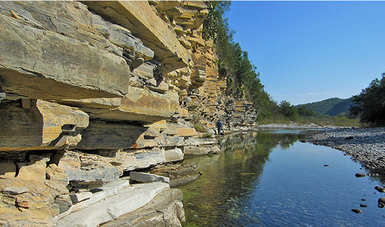
Geology
The Mexican Geological Survey is the agency that generates the geological-mining information of the country. It has vast experience in geological surveying and in mining exploration and evaluation, because it has more than 50 years operating in Mexico in different specialties and in several scales.
An extensive part of the preserved geological information is already historical, although currently still generating, always concerned with mining prospection and exploration. Nevertheless, since 1995, most of the work has been concentrated in creating the basic geologic infrastructure of the national territory, that is, the geological-mining and geochemistry cartography, organized in two programs: 1:250,000 scale maps, and 1:50,000 scale maps. The first one was completed in 2005, and the second is yet in course, with 29% coverage of the Mexican surface.
The geologic maps have outstanding importance in several geology fields, as they can be used in exploration and generation of mining projects, and also in regional geology research in collaboration with, for example, the USGS, the Geology Institutes of UNAM and the universities of Sonora and San Luis Potosí. In addition, constitute the database for editing the 1:4’000,000 scale map of the Mexican Republic, and the 1:500,000 scale state maps.
Among other data, the cartographical program incorporate to the maps all metallic and non-metallic, active or inactive mines, and additionally provides information on mineralization or hydrothermally altered rocks, all of which is registered by a field geologist during his search, as the facts could be related with a potential mineral deposit. On this basis, the SGM produces a number of valuable prospective areas that are classified in order of importance, then evaluated, and finally put into the consideration of interested entities or individuals.
Products
The cartographic products of the SGM have information surveyed directly in the field. The displaying of personnel all over the Mexican territory is a complex effort –and spectacular– as it comprises the organization, mapping, supervision and reviewing of a surprising amount of geological data. Nonetheless, a noticeable quality is obtained in spite of a series of difficulties that have to be saved.
The geological-mining map –and the rest of the coverage and layers– contain an integrated spatial alpha-numeric database in such a way that it can be managed complete, combined or by layer.
Content
The specific information in a map is:
- Infrastructure: carreteras, caminos, poblados, líneas férreas y de electrificación.
- Lithology: tipos de roca, formaciones, cambios de facies, domos, intrusivos.
- Structural: fallas, fracturas, flujos, cabalgaduras, pliegues, discordancias.
- Sampling: análisis de petrografía, paleontología, radiometría, esquirla, difracción.
- Mineral deposits: metálicos y no metálicos, minas, manifestaciones y alteraciones.
- Representative geologic cross sections.
- Stratigraphic column.
- Abstract and final report.
Organization
The field work administration is certified under the ISO 9000-2008 quality standard; the programs are yearly activated, and executed by a crew of 160 compromised field geologists using the most appropriated and up to date tools in their surveying and office occupations. The verified locality coordinates are uploaded to a GPS, so every geological, structural, sampling and mineral deposits data is displayed in the final map. Actually, some test is being made in order to register the information directly in the field to an integrated GPS-photographic camera-hand computer. This technique will allow using a minimum of paper and field-books under favorable conditions.
When the access is difficult, an helicopter is employed, which is also useful to verify advances, collect samples, solve structural problems, or identify mines, altered rocks or mineral traces.
The field information is reproduced in a map or chart. A final report is also available in which the field geological features are described, including geomorphology, stratigraphy, structural geology, tectonics, and a special chapter devoted to mineral deposits, mineral traces and the deposit type as related to a certain hydrothermal alteration. Additionally, a mineralization model is proposed, and lab results, structural data, mines and prospects location, mills, petrography, polished sections, diffraction and paleontological tables are included as supplementary appendixes. The text is illustrated with photographs and all the pertinent and useful information for a future prospection or assessment.
All the maps and reports, with such a valuable information, are issued in paper or digital format, and may be consulted in the web page or purchased from the central offices in Pachuca, and also from the 8 regional offices strategically distributed all over the country.
For further information, please contact:
Dr. Juan Carlos Salinas Prieto
Encargado de la Gerencia de Geología y Geoquímica
Tel.: 01(771) 711-39-30
juancarlossalinas@sgm.gob.mx
 Geology
Geology
- Autor:
- Servicio Geológico Mexicano
- Fecha de publicación:
- 26 de septiembre de 2017
La legalidad, veracidad y la calidad de la información es estricta responsabilidad de la dependencia, entidad o empresa productiva del Estado que la proporcionó en virtud de sus atribuciones y/o facultades normativas.